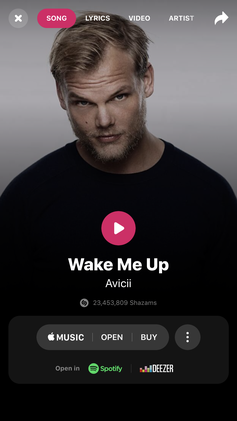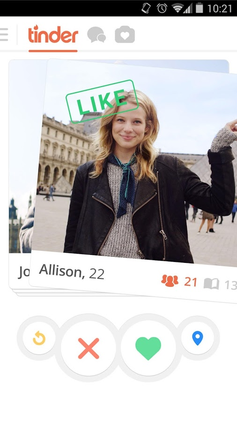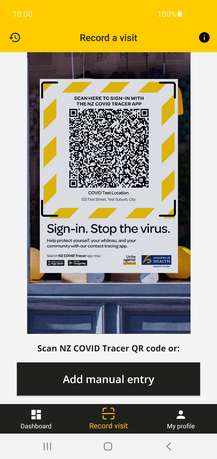 | |
| Initial release | 2017 |
|---|---|
| Platform | |
| Website | smartify |
Smartify is a mobile app which can scan artworks and return information about them. [1]
 | |
| Initial release | 2017 |
|---|---|
| Platform | |
| Website | smartify |
Smartify is a mobile app which can scan artworks and return information about them. [1]
Smartify was founded by four friends in 2015. [2] The app was launched at the Royal Academy of Arts in October 2017. [3]
During the COVID-19 pandemic, the app made content available allowing users to browse items in museums digitally. [2]
The app is available on iOS, Android, and as a web app. [2] Smartify describes itself as "a Shazam for the art world". When an artwork is scanned, Smartify compares it to the artwork in its database. If the artwork is recognised, its name and a description are returned to the user. [3]
The app has been identified as an accessibility aid for visually impaired people who may struggle to see an artwork or text surrounding it, as one can zoom in on a picture of an artwork and read or listen to a description of it. [4]
Jonathan Jones, writing for The Guardian , called the idea that in order to appreciate a work of art one needs to be "spoonfed amazing facts about it ", "erroneous and slightly pathetic". [5]

Digital art refers to any artistic work or practice that uses digital technology as part of the creative or presentation process. It can also refer to computational art that uses and engages with digital media.
Audio description, (AD) also referred to as a video description, described video, or more precisely visual description, is a form of narration used to provide information surrounding key visual elements in a media work for the benefit of blind and visually impaired consumers. These narrations are typically placed during natural pauses in the audio, and sometimes overlap dialogue if deemed necessary. Occasionally when a film briefly has subtitled dialogue in a different language, such as Greedo's confrontation with Han Solo in the 1977 film Star Wars: A New Hope, the narrator will read out the dialogue in character.

The Butler Institute of American Art, located on Wick Avenue in Youngstown, Ohio, United States, was the first museum dedicated exclusively to American art. Established by local industrialist and philanthropist Joseph G. Butler, Jr., the museum has been operating pro bono since 1919. Dedicated in 1919, the original structure is a McKim, Mead and White work listed on the National Register of Historic Places.

Since the Global Positioning System (GPS) was introduced in the late 1980s there have been many attempts to integrate it into a navigation-assistance system for blind and visually impaired people.

Shazam is an application that can identify music based on a short sample played using the microphone on the device. It was created by the British company Shazam Entertainment, based in London, and has been owned by Apple Inc. since 2018. The software is available for Android, macOS, iOS, Wear OS, watchOS and as a Google Chrome extension.
Blind artists are people who are physically unable to see normally, yet work in the visual arts. This seeming contradiction is overcome when one understands that only around 10% of all people with blindness can see absolutely nothing at all. As such most blind people can in fact perceive some level of light and form, and it is by applying this limited vision that many blind artists create intelligible art. Also, a blind person may once have been fully sighted and yet simply lost part of their vision through injury or illness. Blind artists are able to offer insight into the study of blindness and the ways in which art can be perceived by the blind, in order to better improve art education for the visually impaired.
BlindArt is a British charity which was established in 2004 to educate the public about the needs of people who are visually impaired and to promote the idea that lack of sight need not be a barrier to the creation and enjoyment of works of art. BlindArt exhibitions typically contain paintings, sculptures, installations and other works of art which have been designed to engage all the senses. BlindArt pieces are created both by sighted artists or by artists who are blind or partially sighted.

Google Arts & Culture is an online platform of high-resolution images and videos of artworks and cultural artifacts from partner cultural organizations throughout the world.

Instagram is an American photo and video sharing social networking service owned by Meta Platforms. It allows users to upload media that can be edited with filters, be organized by hashtags, and be associated with a location via geographical tagging. Posts can be shared publicly or with preapproved followers. Users can browse other users' content by tags and locations, view trending content, like photos, and follow other users to add their content to a personal feed. A Meta-operated image-centric social media platform, it is available on iOS, Android, Windows 10, and the web. Users can take photos and edit them using built-in filters and other tools, then share them on other social media platforms like Facebook. It supports 32 languages including English, Spanish, French, Korean, and Japanese.

Tinder is an online dating and geosocial networking application launched in 2012. On Tinder, users "swipe right" to like or "swipe left" to dislike other users' profiles, which include their photos, a short bio, and some of their interests. Tinder uses a "double opt-in" system, also called "matching", where two users must like each other before they can exchange messages.

tvOS is an operating system developed by Apple Inc. for the Apple TV, a digital media player. In the first-generation Apple TV, Apple TV Software was based on Mac OS X. Starting with the second-generation, it is based on the iOS operating system and has many similar frameworks, technologies, and concepts.

DICE is a ticketing software company based in London, United Kingdom. Its web and mobile technology products enable users to search, browse and buy tickets to all kinds of live events, including concerts, festivals, comedy shows and other types of performances or talks. DICE gained popularity as a ticketing app for its strong stance against scalping, implementing guardrails within its products to limit fraud and price gouging. DICE also develops technology products for live show organisers and promoters for them to manage event marketing and better understand their audiences.
Google Talkback is an accessibility service for the Android operating system that helps blind and visually impaired users to interact with their devices. It uses spoken words, vibration and other audible feedback to allow the user to know what is happening on the screen allowing the user to better interact with their device. The service is pre-installed on many Android devices, and it became part of the Android Accessibility Suite in 2017. According to the Google Play Store, the Android Accessibility Suite has been downloaded over five billion times, including devices that have the suite preinstalled.
Oswald Labs is a Dutch-Indian based accessibility technology company that builds products for individuals with disabilities. It specializes in enterprise web accessibility, offers smartphone apps, and also runs a startup accelerator. It was established in 2016 by Anand Chowdhary, Nishant Gadihoke and Mahendra Raghuwanshi after their product, Oswald Extension, won an event at the AngelHack hackathon in New Delhi.
Accessibility apps are mobile apps that increase the accessibility of a device for individuals with disabilities. Accessibility apps are applications that increase the accessibility of a device or technology for individuals with disabilities. Applications, also known as, application software, are programs that are designed for end users to be able to perform specific tasks. There are many different types of apps, some examples include, word processors, web browsers, media players, console games, photo editors, accounting applications and flight simulators. Accessibility in general refers to making the design of products and environment more accommodating to those with disabilities. Accessibility apps can also include making a current version of software or hardware more accessible by adding features. Accessibility apps main aim is to remove any barriers to technological goods and services, making the app available to any group of society to use. A basic example is that a person who experiences vision impairments is able to access technology through enabling voice recognition and text-to-speech software. Accessibility apps are closely related to assistive technology.
Seeing AI is an artificial intelligence application developed by Microsoft for iOS. Seeing AI uses the device camera to identify people and objects, and then the app audibly describes those objects for people with visual impairment.
Climate change art is art inspired by climate change and global warming, generally intended to overcome humans' hardwired tendency to value personal experience over data and to disengage from data-based representations by making the data "vivid and accessible". One of the goal of climate change art is to "raise awareness of the crisis", as well as engage viewers politically and environmentally.

NZ COVID Tracer is a mobile software application that enables a person to record places they have visited, in order to facilitate tracing who may have been in contact with a person infected with the COVID-19 virus. The app allows users to scan official QR codes at the premises of businesses and other organisations they visit, to create a digital diary. It was launched by New Zealand's Ministry of Health on 20 May 2020, during the ongoing COVID-19 pandemic. It can be downloaded from the App Store and Google Play.

Corona-Warn-App was the official and open-source COVID-19 contact tracing app used for digital contact tracing in Germany made by SAP and Deutsche Telekom subsidiary T-Systems.
Be My Eyes is a Danish mobile app that aims to help blind and visually impaired people to recognize objects and cope with everyday situations. An online community of sighted volunteers receive photos or videos from randomly assigned affected individuals and assist via live chat. The app is currently available for Android and iOS.